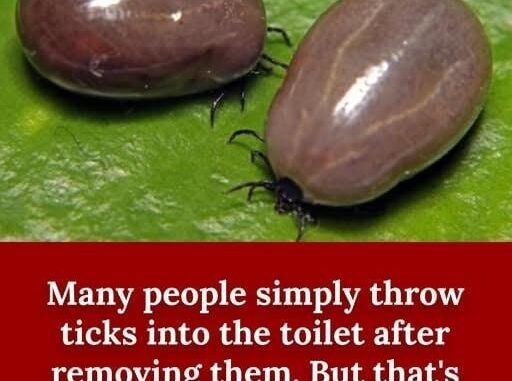
How To Properly Dispose of Ticks
Ticks are small arachnids that feed on the blood of mammals, birds, and sometimes reptiles and amphibians. While they may seem harmless, ticks can carry diseases that can be transmitted to humans through their bites. Proper removal and disposal of ticks are essential to reduce the risk of contracting tick-borne illnesses.
The Problem with Ticks
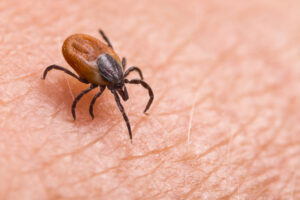
Source: Shutterstock
Ticks are known vectors for various diseases such as Lyme disease, Rocky Mountain spotted fever, and babesiosis. These diseases can have serious consequences if left untreated, making it crucial to take precautions when dealing with ticks.
No one wants to be bitten by a tick, especially not our four-legged best friend. Knowing how to remove a tick safely and effectively is crucial to protecting your pet from infection, and disposing of the tick afterwards is all part of this process. Scroll to find out what to do with a tick once you’ve pulled it off your pet.
How To Properly Dispose of Ticks
You’ve Got a Tick On You – What Should You Do?
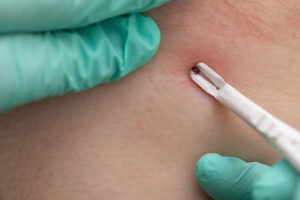
Source: Shutterstock
If you find a tick attached to your skin, the first step is to remove it carefully and promptly. Using fine-tipped forceps or tweezers, grasp the tick as close to your skin as possible and gently pull it out in a single continuous motion. Avoid squeezing or twisting the tick, as this may cause it to regurgitate its contents into the wound.
There’s an abundance of information on how to safely remove ticks from your pet or yourself. However, the question of what to do with the ousted tick often gets lost in the conversation.
Well done for removing the tick from your pet or yourself. Let’s make sure it has no way of getting back into your home!
What to do with a removed tick
How To Properly Dispose of Ticks
What Not to Do When You Have a Tick On You
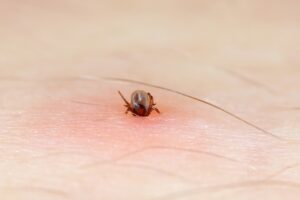
Source: Shutterstock
It is important to refrain from using home remedies such as matches, nail polish remover, or Vaseline to remove a tick. These methods can agitate the tick and increase the risk of disease transmission. Additionally, avoid squeezing the tick or attempting to burn it off, as this can also lead to regurgitation of harmful bacteria.
How To Properly Dispose of Ticks
How to Dispose of the Tick
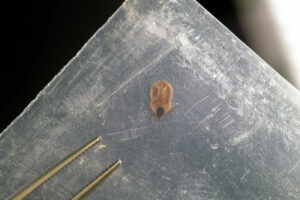
After successfully removing the tick from your skin, it is important to dispose of it properly. Place the tick in a sealed bag or container to prevent any potential contact with humans or animals. Alternatively, you can flush the tick down the toilet. Proper disposal of ticks helps to prevent further contact and potential transmission of diseases.
Alcohol or soapy water – After successful tick removal, submerge the tick in a small container filled with rubbing alcohol or soapy water. The alcohol or soapy water will kill the tick, ensuring it cannot pose any further threat.
Seal in a plastic bag – For those who prefer not to handle ticks directly, use tweezers or a tissue to pick up the tick and place it in a sealable plastic bag. Seal the bag tightly, ensuring there is no chance for the tick to escape.
Toilet disposal – While flushing ticks down the toilet is a common instinct, it’s not the most environmentally friendly option. If you choose this method, make sure the tick is completely submerged and flushed away promptly.
How to stop ticks coming back
So you never have to remove one again, here’s how to prevent ticks on your pet:
Tick preventatives: Use regular tick preventatives like Itch Flea Treatment for dogs and Itch Flea Treatment for cats (kills ticks and lice too!). Tick treatments like this don’t stop the pest from crawling onto your pet, but it will kill it within 48 hours of it latching on so it drops off.
Regular grooming: Establish a routine grooming schedule for your pets. Regular brushing not only keeps their coat healthy but also allows you to detect and remove ticks promptly.
Tick checks: Perform thorough tick checks on your pets and yourself after outdoor activities. Run your hands over the entire body, paying close attention to areas where ticks commonly attach.
Cleaning: Don’t just spring clean… regularly clean and hoover your home, focusing on areas where your pets frequent a lot! Wash bedding, blankets, and any fabric items your pets use in hot water (at least 60°C) to eliminate tick eggs and larvae.
Tick-prone areas: Be mindful of where your pets roam around, especially during peak tick season. Avoid areas known for high tick populations, and stick to well worn in and maintained paths during walkies.
Protect your garden: Utilise tick preventatives in your outdoor areas, especially if your pets spend time outside. Products like sprays and plants can help repel ticks in your environment.
Tick-borne diseases: Stay informed about tick-borne diseases prevalent in your area. Knowing the signs and symptoms allows for early detection and prompt vet intervention if necessary.
Year-round vigilance: Ticks can be active throughout the year, depending on your location and climate. Consider year-round tick prevention (not just in peak season!) to maintain continuous protection against potential infestations.
Disposing of a removed tick responsibly is an essential step in ensuring the safety of both humans and pets. Choosing the right disposal method and adopting preventive measures will not only bid farewell to ticks but also create a healthier and more tick-resistant environment for everyone involved.